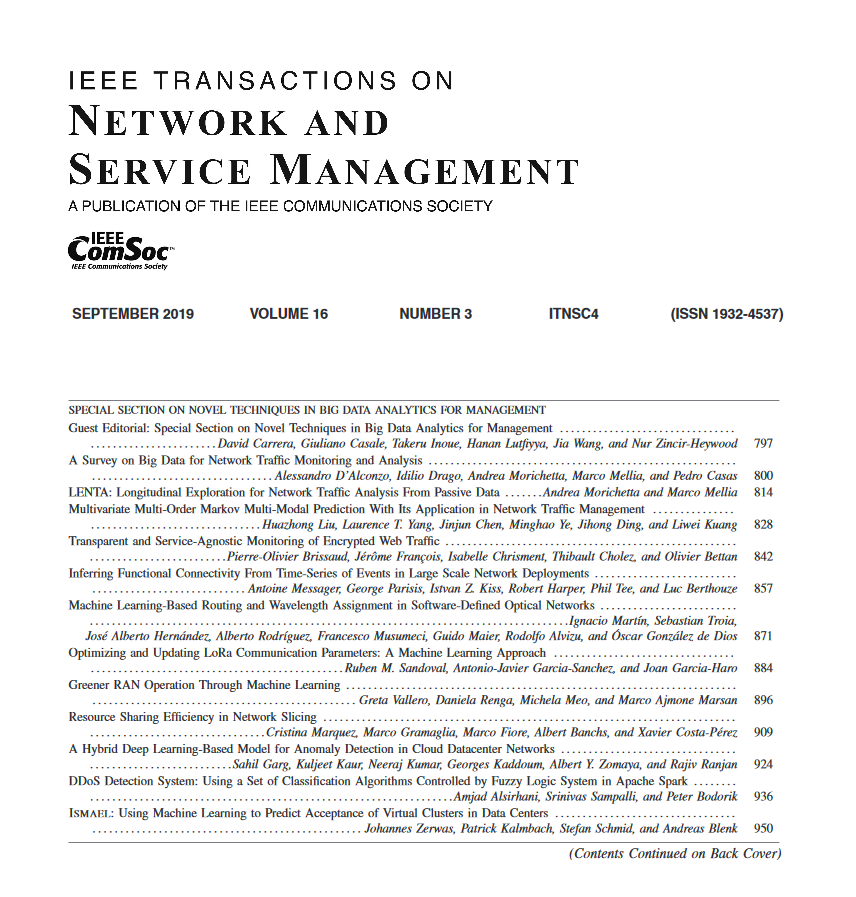多 AAV 辅助 MEC 中队列模型的延迟和负载公平性优化:一种深度强化学习方法
IF 5.4
2区 计算机科学
Q1 COMPUTER SCIENCE, INFORMATION SYSTEMS
IEEE Transactions on Network and Service Management
Pub Date : 2024-12-19
DOI:10.1109/TNSM.2024.3520632
引用次数: 0
摘要
自主飞行器(Autonomous aerial vehicle, AAV)可以通过辅助计算减轻边缘设备的计算负担。然而,随着物联网设备数量的增加,有必要在AAV上建立任务队列来调度物联网设备的计算任务。此外,还应优化aav的负载公平性,以充分利用计算资源。为此,提出了一种基于排队模型的多aav辅助移动边缘计算(MEC)网络框架,旨在优化所有用户设备的平均延迟和aav的负载公平性。首先,我们证明了不同计算延迟的任务在AAV队列上的排列会影响用户的平均延迟,因此提出了一种短作业优先(SJF)队列模型以最小化用户的平均延迟。在此基础上,提出了AAV三维轨迹与用户连接调度的联合优化问题。提出了一种基于SJF的低复杂度连接调度算法,并将其与深度强化学习(DRL)相结合来解决这一np困难问题。为了评估该算法的性能,我们将其与深度确定性策略梯度(DDPG)、粒子群优化(PSO)、随机移动(RM)和局部计算(LC)进行了比较。仿真结果表明,该算法有效地降低了用户平均时延,提高了AAV负载公平性。最后,将SJF与传统的先到先服务(FCFS)排队模型在不同算法上进行了比较。结果表明,SJF的平均延迟明显低于FCFS。本文章由计算机程序翻译,如有差异,请以英文原文为准。
Delay and Load Fairness Optimization With Queuing Model in Multi-AAV Assisted MEC: A Deep Reinforcement Learning Approach
Autonomous aerial vehicles (AAV) can alleviate the computational burden on edge devices through assisted computing. However, with the increase in the number of Internet of Things Devices (IoTDs), it is essential to establish a task queue on the AAV to schedule computing tasks from IoTDs. In addition, the load fairness of AAVs should be optimized to fully utilize the computing resources. Therefore, a multi-AAV-assisted mobile edge computing (MEC) network framework based on the queuing model is proposed, which aims at optimizing the average delay of all user devices and the load fairness of AAVs. Firstly, we prove that the arrangement of tasks with different computing delays on the AAV queue can affect the user’s average delay, so a short-job-first (SJF) queuing model is proposed to minimize the average delay of users. On this basis, a joint optimization problem related to the AAV’s three-dimensional trajectory and user connection scheduling is formulated. A SJF based low-complexity connection scheduling algorithm is proposed and combined in a deep reinforcement learning (DRL) to solve this NP-hard problem. To evaluate the performance of the proposed algorithm, we compare it with deep deterministic policy gradient (DDPG), particle swarm optimization (PSO), random moving (RM), and local computing (LC). Simulation results show that our algorithm effectively reduces user average delay and enhances AAV load fairness. Finally, SJF is compared with the traditional first-come-first-served (FCFS) queuing model on different algorithms. The results indicate that the average delay of SJF is significantly lower than that of FCFS.
求助全文
通过发布文献求助,成功后即可免费获取论文全文。
去求助
来源期刊

IEEE Transactions on Network and Service Management
Computer Science-Computer Networks and Communications
CiteScore
9.30
自引率
15.10%
发文量
325
期刊介绍:
IEEE Transactions on Network and Service Management will publish (online only) peerreviewed archival quality papers that advance the state-of-the-art and practical applications of network and service management. Theoretical research contributions (presenting new concepts and techniques) and applied contributions (reporting on experiences and experiments with actual systems) will be encouraged. These transactions will focus on the key technical issues related to: Management Models, Architectures and Frameworks; Service Provisioning, Reliability and Quality Assurance; Management Functions; Enabling Technologies; Information and Communication Models; Policies; Applications and Case Studies; Emerging Technologies and Standards.
 求助内容:
求助内容: 应助结果提醒方式:
应助结果提醒方式:


